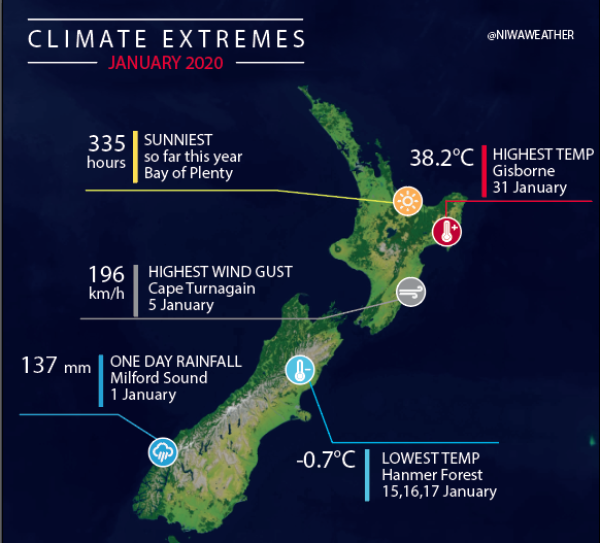January - a month of two halves
|
Rainfall |
It was a very dry January with much of the country observing rainfall below (50-79% of normal) to well below (<50%) normal. Parts of upper North Island and upper and eastern South Island received less than 10% of their long term January rainfall normal. Only small portions of western Fiordland and coastal Waitaki District observed near normal (80-119%) rainfall. |
|
Temperature |
Temperatures were well above average (>1.20°C above average) for parts of interior Mackenzie and Waimate Districts. Temperatures were above average (0.51-1.20°C above average) in much of interior central Canterbury and Otago, the Hurunui District and northern Tasman. Temperatures were mostly near average (-0.5 to +0.5°C of average) in the rest of the South Island but small portions of below average temperatures (0.51-1.20°C below average) were experienced in coastal Westland and coastal lower Canterbury. In the North Island, temperatures were mostly near average, but above average temperatures were observed in parts of eastern Northland, Coromandel, Bay of Plenty, Gisborne and Hawke’s Bay. Small portions of below average temperatures were observed in western Waikato and lower Wellington Region. |
|
Soil Moisture |
By the end of January, soil moisture levels were below to well below normal for the entire North Island and meteorological drought was present in much of the upper North Island with severe meteorological drought in northern Auckland, Great Barrier Island, southern Northland, and the Aupouri Peninsula according to NIWA’s New Zealand Drought Index. Soils were drier than normal for much of the South Island as well, the only exceptions being Fiordland, the lower West Coast, Dunedin and the Grey District where near normal or above normal soil moisture levels were observed. |
Overview
January 2020 was characterised by above normal pressure over and west of New Zealand and below normal pressure east of the country. This pressure set up was associated with a southeast air flow anomaly for eastern areas and a southwest air flow anomaly for western areas.
Below or well below normal rainfall was widespread across New Zealand during January. This was a result of dry, southerly-quarter winds with an area of high pressure frequently near and west of New Zealand. As of 31 January, many locations across the South Island were experiencing record or near-record long dry spells and meteorological drought was present in much of the upper North Island with severe meteorological drought in northern Auckland, Great Barrier Island, southern Northland, and the Aupouri Peninsula according to NIWA’s New Zealand Drought Index.
January temperatures were a tale of two halves; the month started out cooler than usual for much of the country, with many locations on track to observe near-record low mean temperatures for the month. During the second half of the month, the persistent area of high pressure near and west of New Zealand shifted slightly farther north, allowing the transport of warmer airmasses from Australia to New Zealand. This brought well above average temperatures, particularly during the last week of January. Overall, this meant New Zealand’s January temperature ended near average; the nationwide average temperature in January 2020 was 17.2°C. This was 0.1°C above the 1981-2010 January average from NIWA’s seven station temperature series which begins in 1909.
New Zealand has not had a month with below average temperatures in 36 months, or since January 2017.
Further highlights:
- The highest temperature was 38.2˚C, observed at Gisborne on 31 January. This was New Zealand’s 5th-hottest January temperature on record as well as the 19th-equal hottest temperature on record for any month.
- The lowest temperature of the month was -0.7˚C, observed at Hanmer Forest on 15, 16, and 17 January.
- The highest 1-day rainfall was 137 mm, recorded at Milford Sound on 1 January.
- The highest wind gust was 196 km/h, observed at Cape Turnagain on 5 January.
- Of the six main centres in January 2020, Tauranga was the warmest and sunniest, Dunedin was the coldest and wettest, Christchurch was the driest, and Wellington was the least sunny.
- Of the available, regularly reporting sunshine observation sites, the sunniest four locations in 2020 so far are Bay of Plenty (335 hours), Waikato (323 hours), Taranaki (318 hours) and Wider Nelson (308 hours).


